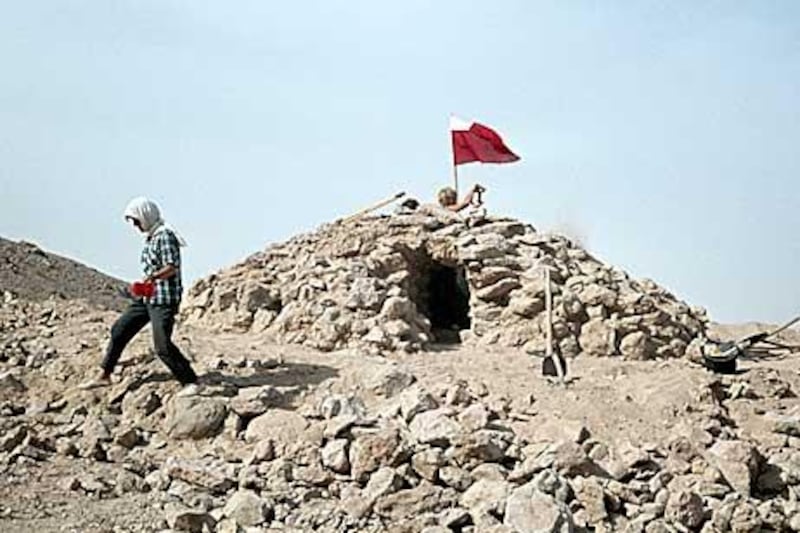The archaeologist Jens Vellev - the Danish Indiana Jones - is best known for his efforts investigating the death of the astronomer Tycho Brahe. But he started out by excavating tombs in Al Ain thought to date back to the second millennium BC. Erin Conroy reports
Today, he is the world-renowned archaeologist making headlines for his attempts to solve the puzzling death, more than 400 years ago, of a famed astronomer.
But at the start of his career more than four decades ago, Jens Vellev admits he was a wide-eyed amateur eager to start his first major excavation: Al Ain's ancient tombs.
Often called the Danish Indiana Jones, Prof Vellev has recently received worldwide acclaim for exhuming the body of Tycho Brahe, whose demise has been shrouded in mystery for centuries. The stargazer who made some of the most accurate measurements of the sky without a telescope was widely thought to have died from a burst bladder, though some have speculated he was murdered.
Prof Vellev's excavating days began in 1969, when he was part of a team to unearth the tombs of Bida bint Saud in Al Ain, a group of burial chambers from the Late Bronze Age and Early Iron Age and other artefacts.
The tombs were estimated to date as far back as the second millennium BC.
At 25 years old, "it was incredible to see that part of the world and find pottery and jewels in the burial mounds," said Prof Vellev, who is now an associate professor of medieval archaeology at Aarhus University in Denmark.
"It was such an exciting opportunity at the time, and really sparked my interest for other projects in Asia and then around the world. At the time I was just fascinated."
He spoke regularly with Sheikh Zayed concerning the team's progress, just as the country's late founder was finalising the unification of the emirates, he said.
"He was excited and impressed with what we were doing," he said.
"He had his castle there in Al Ain, and he came out regularly to look at what we would do. It was his history, of course, that we were excavating."
Beginning in 1959, a decade before Prof Vellev was involved in the project, Sheikh Zayed and his brother, the former Abu Dhabi ruler Sheikh Shakhbut, drove Danish teams from Moesgård Museum in Denmark to sites where they knew ancient remains were buried, determined to find out exactly how old they were.
The sites included Jebel Hafeet and Hili in Al Ain, and the island Umm al-Nar near the city of Abu Dhabi.
What they discovered in the tombs and the sediment were traces of craftmanship imported from ancient Mesopotamia.
"The local community knew that these ancient remains and treasures were there, but did not know how far back they went," said Dr Walid Yassin, the manager of archaeology at the Abu Dhabi Authority for Culture and Heritage.
"What they found, for the first time, was that this area was not isolated at all."
Dr Yassin has been collecting portraits and stories from the Danish team for an upcoming exhibition to mark the 50th anniversary of the city's first completed excavation. Planning is still in the early stages, but the exhibition "will show not only the findings but the life of the archaeologists while they were here, how archaeology has changed here and how life in the emirate has changed," he said.
Prof Vellev remembers spending time with Bedouin tribesmen, "taking their portraits, learning their names and making friendships with them," he said.
After spending two six-month periods in Al Ain during those two years, Prof Vellev went on to dig up the Viborg Cathedral in Denmark, that dates back to the Viking Age, as well as other medieval castles and bridges. He became interested in Tycho Brahe more than a decade ago after reconstructing a paper mill from the same time period as one owned by the scientist.
This year, he began an investigation into the cause of Brahe's death, opening his tomb in Prague for samples of bone, teeth and hair.
He is currently in Sweden conducting tests on the astronomer's beard, the first analysis of the remains. The investigation will take at least a year, he said.
Prof Vellev believes that a fatal dose of homemade medicine led to mercury poisoning.
"We are just trying to find out what happened," he said. "He likely had pain, made medicine himself and, perhaps, it was just too much. But it will take time before we know for sure."
Working closely with the Denmark museum, Prof Vellev said he regularly sees members of his very first excavation team and, though he has not been back to Abu Dhabi, plans to visit when the exhibition opens.
"I know that in Al Ain, what was once just desert has become a big city, so I'm interested to see how life there has changed," he said.
"But I expect the burial mounds will be just the same."
Bad bladder or conspiracy?
When Tycho Brahe died in 1601 at the age of 54, it was widely thought his bladder had burst because he refused to excuse himself at parties.
But that has since been disputed by theories claiming an opportunistic assistant, relative or even Danish royalty could have murdered the brilliant astronomer. Prof Jens Vellev believes Brahe died from kidney failure after ingesting a fatal amount of mercury in a batch of self-made medicine.
Others have offered more scandalous theories. It has been claimed that the diary of a distant cousin, Eric Brahe, contains a confession to killing the scientist. He was supposedly contracted by King Christian IV, who believed Brahe had been having an affair with his mother, Queen Sophie. Brahe’s assistant, Johannes Kepler, is also a suspect.
Kepler went on to prove that the planets revolve around the sun, known today as Kepler’s laws of planetary motion, based partly on his mentor’s ideas.






